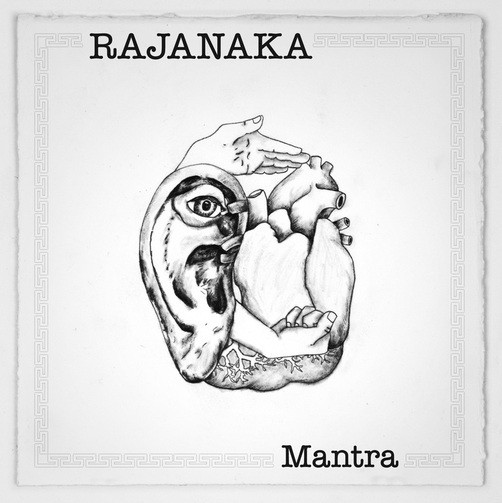
Brad Roberts
Rajanaka: Mantra
Album US 2011 on Deep Fried Records label
Electronic, Folk, World and (Ambient)
Notes by Eric Stoneberg mantra man: mind tra: to cross tantra tan: to extend tra: to cross To step into the conversation of Yoga is to step into a deep ocean indeed. In this conversation, some voices will dominate, just as certain oceanic currents dominate the seas. Hidden beneath the surface of things, ebbing toward distant lands - unknown because unlooked for - there are currents whose purpose is to evoke the artistry of the heart, to celebrate the beauty of life itself. This is the yoga of the Householder’s Tantra, the engagement that extends the heart’s intrinsic beauty and crosses that artistry back into the world for the sake of savoring, of tasting the vibrancy of life’s kaleidoscopic possibilities. Some of the dominant currents within the vast ocean of yoga, especially those which have presided over the transmission of yoga to the West, propose that yoga is the solution to the problem of life; that yoga frees us from suffering. While this is a glib oversimplification of an expansive sea of teachings, it is the general attitude from which many of the dominant traditions begin. The Tantrics make an important shift away from this line of reasoning and so begin with a radically different notion as to the very purpose of yoga. For the Tantric, life is not first and foremost a problem, it is instead a gift of grace - and yoga is its blessing. Rather than enter into a problem-solving paradigm for yogic practice that moves from suffering and bondage toward liberation and freedom, the tantric starts with freedom as his or her intrinsic nature. Freedom is the beginning rather than the end. Life is an ever-evolving gift, and a gift freely given can be received in myriad ways. That gift might be squandered or treasured, valued or denied – ultimately one is free to accept and engage that gift in any way one desires. The Tantric affirms freedom as the auspicious point of departure. You are already free. So what would be worthwhile enough to bind yourself to? For one, the Householder binds herself to a visionary understanding of enlightenment. All yoga traditions are invested in this term, but the way in which it is defined and understood can vary widely. Traditionally, enlightenment is conceived as an action or state of attaining or having attained ultimate spiritual knowledge or insight. In some traditions this state is thought to free one from samsara, or the cycles of death and rebirth. Oftentimes, an enlightened master will dispense these insights to seekers who ask for such wisdom. And much of yoga, especially as it has been transmitted to the West, comes through the ascetical tradition. That is, spiritual wisdom is dispensed through renunciates, those who have given up worldly concerns for the sake of a spiritual commitment. Much of the language of contemporary yoga is flavored by these traditions even when the spiritual guide is not in fact a renunciate. For example, traditionalists will define yoga as the stopping or cessation of the turnings of the mind. Stop, cease, slow, quiet, witness – these are the first action verbs one hears when one enters the traditional current. By contrast, the Householder tantric starts with a different set of assumptions - for a Householder’s nature is worldly, not ascetical. The worldly being who presumes life is a gift (and not a penance) will cultivate a different set of action verbs as his or her dominant mode of yogic engagement. Enter into, align with, participate, engage, savor and become – all these belong to the primary language of the Householder. Enlightenment becomes less about attaining a Divine spiritual state removed from one’s everyday experience, and more of an ever-deepening process of reflection and recognition of the Divine as everyday life. Embodiment is a gift, and that gift comes with sorrow and joy, delight and dread - a full spectrum of feelings and thoughts and experiences. To radically affirm this full spectrum is to begin the process of yoga that engages all that life can be - from the silly to the sublime. For the Householder, enlightenment is not a fixed state of consciousness that stands apart from humanity. Without ever denying the rich presence of great beings with remarkable spiritual gifts, Enlightenment need not be an end or a state of final ultimate achievement. Instead, it is an expansive process of ever-deepening inquiry and insight. Life is an auspicious gift and yoga strives to engage its inherent value, prosperity and benevolence. Images of enlightenment become less otherworldly and transcendent in the tantric traditions and instead veer toward the language of artistic appreciation. The Householder lineages are the keepers and masters of Yoga Rasa. Rasa means flavor, essence or taste. All of life’s diverse experiences come with varied tastes, flavors on the palate of humanity. From the gruesome to the courageous, the comic to the fearsome, Rasa theory strives to appreciate the artistry of embodiment through a complex system of aesthetic insight. Only a tantric yoga that starts with the premise that life is a gift - not a problem to solve or a transaction to achieve – would invest so seriously in the system of poetic expression and reflective appreciation that is Rasa. This album is inspired by the teachings of the great Rasika, or yogis who are masters of life’s flavors. And the tracks here are in part an exploration of that current within the tantric tradition. The assumptions one begins with are sure to guide not only the practices but also the insights one might discover while navigating the currents of yoga. In a problem-solving yoga, engagement of the body and mind tend toward models of purification - of quelling, staunching or stopping the things that get in the way of one’s freedom. Spiritual progress in this way tends to be made on a vertical model, like climbing rungs on a ladder; progress on this path gears itself toward attainment of an optimal state of Consciousness that is always just out of reach. For the tantrums, particularly those lineages of Householders who forgo this vertical model and instead cultivate a yoga that radically affirms the gift of life - and all that comes in the wake of such a gift - the practices of yoga are not driven by purification and attainment. Instead, the engagement of yoga is for the sake of enjoyment and artful evocation. Ask a tantric why she meditates, or does any number of yogic practices, and she is sure to tell you that she does it foremost because she enjoys it. A practice one does not like is incredibly challenging to sustain. To evoke is to summon forth, to reach into the dark cave of the heart and draw from it forms of beauty that are worth appreciating, savoring and tasting to their fullness. The Householder yogis are not merely philosophers, but rather artists and poets of life living freely in the world and freely engaging worldly concerns. For the world is in fact one of life’s gifts. And while a yoga of enjoyment could move dangerously toward a current of hedonism or self-aggrandizement, the Householder tantric remembers to serve, to magnify and to enhance the gift of life for others as well as for herself. Life is valuable, beneficent and abundant. The artistry of yogic engagement strives to recognize these features as one’s own experience. May we reach into the heart of the Divine by reaching into our own hearts, not to get out or get through this life, but to evoke the worlds of beauty that already reside within us. The tantric’s aim is not to get out of his or her humanity and into to some transcendent place, but to fully access her humanity artfully, to recognize oneself as the Divine’s gift. To this end, there is nothing to get out of; there is only ever more to descend in upon. Rajanaka Mantra is the artful celebration of some of the private practices of a living lineage of Householder tantra, specifically those currents elucidated by Dr. Douglas Brooks. The mantras come through his lineage, but are interpreted and performed with the principle of freedom at the forefront of the imagination of the artists who created it. Yoga is not empowering unless and until one has made its practices one’s own. Rajanaka Mantra in this way is an exploration of evocative mantra. Often cultivated privately and spoken silently to oneself, these songs instead are the embodied expression of the Divine turned inside out. To that end, the format of the songs does not follow a usual call-and-response pattern of song styling typical of the devotionalist yoga tradition. This paradigm shift encourages listeners to freely enter into the mantra; to step into the current; to evoke in oneself that which is evoked here; to in fact, become the song, sung. - liner notes written by Eric Stoneberg, Certified Anusara® Yoga Instructor 1. Siva’s Bija This mula, or root, mantra belongs to Shiva as Nataraja, the ecstatic dancer who resides in the Hall of Consciousness at the temple of Cidambarum in South India. The Natarajamulamantra is said to be swadiksha, or self-initiating. The mythic construct of the mantra gives the first half “namah shivaya” to Shivakamasundari, his consort whose name means “The One Who Shiva Desires.” She praises and names her beloved and then he replies with a series of bijas, “slim pashu hum phat.” Bijas are like indestructible resonant seeds, sonic power at its densest and most essential level. Bijas are not translated literally with syntactical meaning, but are instead planted into Consciousness as seeds for cultivating evocative potency. 2. Om Namo Ganapataye Here we learn Ganapati’s laghu mula-mantra, the “light” version of his mula (root) mantra. In the Tantric tradition, to name is to invoke presence. When forms are named – and only when they are named – can they become food. The tantric longs for evocative sustenance in her embodiment and so there is little stock given to those forms which are said by some to be “beyond words.” Such language of ineffability is reserved for the problem-solving traditions; for language - a feature of embodiment - is surely a problem in their minds. By contrast, the poets of the tantra long for more language, not less. For with more words one has more artful possibilities in life. Only by naming one’s experience can one grab hold of it, assimilate and digest it says the Tantric. And so Om Namo Ganapataye names this great Ganapati, which is his preferred name among some lineages of Householders. (Ganesha tends to be the name one hears most often in the West.) Ganapati’s name suggests an evocative presence that could be valuable to worldly beings. Gana stands for a rabble, a cacophonous herd, or group. The world itself is a rabble of simultaneous connections; in any given second there is an infinitude of complex relationships playing out. Pat stands for discretionary power, something that is pat is brought into form. So, though the world is a rabble, Ganapati sorts it all out into manageable forms. His twisted trunk, like the twisted path of one’s own life, is often depicted reaching into a bowl of sweets, reminding us to make sweet choices along our path. His tusk is broken, and he uses his broken tusk as a pen. That broken feature is in fact his instrument of creativity, reminding the Householder that those things that seem broken need not be problematic. Those seemingly broken features of one’s own consciousness are in fact creative tools. 3. By Any & All Means This line of text, drawn forth from the Rg Veda, can be used at the beginning of a meditation practice as a means of setting the stage, granting oneself permission to explore a new state of consciousness, or simply create the context for entry into the mind and heart. Mahodevo refers to Shiva as the great light who liberates us from death. Loosely translated the rest of this mantra says that we may gain entry “in any different way, all to the core.” 4. Between the Reeds The mantra here is a co-mingled partnership between Ganapati and his brother Subrahmanya. While many mantras are devoted to a singular form or aspect of the Divine, the Rajanaka tradition seeks opportunities to engage in sammelena, or combinatory practice. The partnership here includes the sons of Shiva and also their consorts. The bijas GLIM GLAUM and GAM belong to Hri, Pushti and Ganapati respectively. SAUM and SVAUM are assigned to the consorts of Subrahmanya, Valli and Deviyani. Subrahmanya himself is not assigned a bija in this particular sammelena but is rather hidden in the six spaces between and surrounding the five primary bijas. In tantric lore, this lesser known son of Shiva is often found lurking out of sight, purposely hidden in a thicket of reeds. He is strongly associated with the number six being one of the only deities to wear six faces. 5. The Wonderful Destroyer This three-pronged mantra honors the Lord of Yoga, Shiva, in three of his forms and is an obscure and very secreted mantra from the Rajanaka tradition called Shiva-traya. First in line is Pashupati, Lord of Creatures. Pashupati is an ancient and primal form of Shiva, animistic in nature – honored here and also marked by “vau shat” which is spoken in ancient Vedic sacrifice when one priest passes off the rites of the ritual offering to another. Here, the creaturely form of Shiva is passed off to Bhairava, Shiva in his most frightful and terrifying form. That form is moved through the fire of transformation by “swaha,” which means quite literally “to throw into the fire.” Shiva then transforms to his seated meditative aspect as auspicious and knowledgeable teacher in Dakshinamurti. Here he is named, praised “namah” and so the cycle repeats. 6. Lalita This is Saptabija, a series of seven bijas, or indestructible seed sounds. This particular string of bijas is sometimes associated with the goddess Lalita Tripura Sundari, “She Who Is Lovely in Three Worlds,” and a key figure especially in the tantric devotional practices of the Sri Vidya, or Auspicious Wisdom traditions. These seeds form the heart of the matrika-shakti – the power of the little mothers – that are the syllables holding the power of the great gods manifesting in myriad forms. 7. Invocation This Shiva invocation is attributed to a text called the Rudra Yamala. These very famous verses actually appear in dozens of sources. A Maha-mantra, or great mantra, the verses serve to instill inspiration and blessings among and across communities. For the tantric yogi, Enlightenment is a collective endeavor of ever-expanding awareness – we are as great as the company we keep. This maha-mantra describes the essence that permeates and creates all humanity. Om Namah Shivaya Gurave I honor the essence of Being, the Auspicious One, the luminous teacher within and without, Satchidananda Murtaye who assumes the forms of Truth, Consciousness and Bliss, Nishprapanchaya Shantaya Is never absent, full of peace, Niralambaya Tejase ultimately free and sparkles with a Divine luster. 8. Twisted Trunk Ganapati is the most widely recognized in all the pantheon of Hindu gods. Across cultures and continents, there are few people on the planet who have not encountered “the elephant-headed Lord” in some form or fashion. His expansive, ubiquitous presence is a favorite starting place for in depth study of the Indian deities among tantric practitioners. While there are several versions of this mantra, this celebratory gayatri mantra is a favorite of Douglas Brooks and the one passed along in his lineage. tat parushaya vidmahe vakratundaya dhimahi tano’dantih prachodayat That supreme Self; may we know as our own experience! Let us contemplate the one whose trunk is twisted! May the one with one tusk illumine our minds!
Musicians
 | Brad Roberts voc, g, *1964 CA album by |
Producers
| Terry Derkach producer |
Album Tracks
| No | Title | Artist | Composer | Duration |
|---|---|---|---|---|
| 1 | Shiva Bija | Brad Roberts | 4:03 | |
| 2 | Om Namo Ganapataye | Brad Roberts | 5:43 | |
| 3 | By Any & All Means | Brad Roberts | 3:13 | |
| 4 | Between The Reeds | Brad Roberts | 3:42 | |
| 5 | The Wonderful Destroyer | Brad Roberts | 5:43 | |
| 6 | La Litra | Brad Roberts | 5:17 | |
| 7 | Invocation | Brad Roberts | 5:06 | |
| 8 | Twisted Trunk | Brad Roberts | 3:43 |
